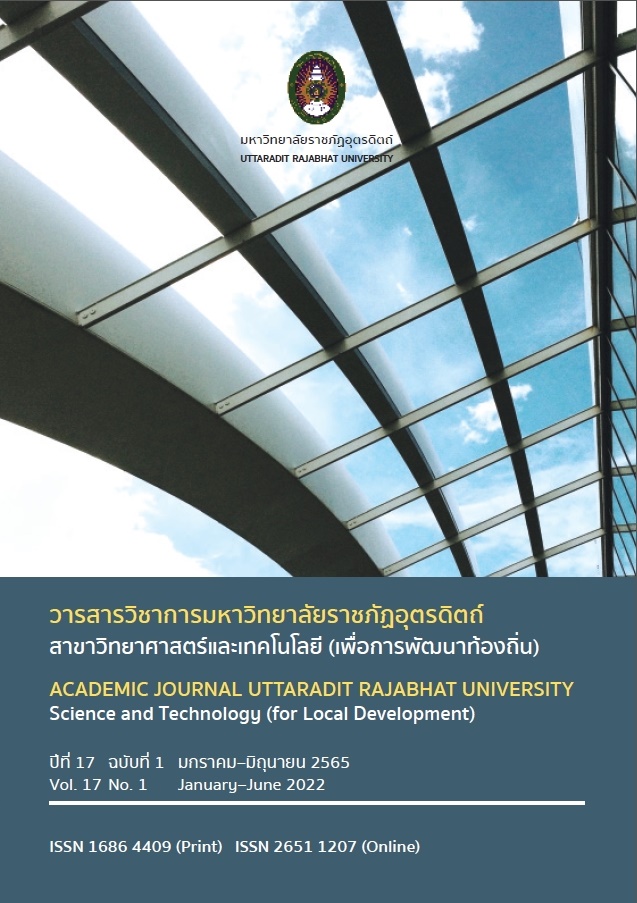การจำลองสมรรถนะของระบบผลิตไฟฟ้าเซลล์แสงอาทิตย์บนหลังคา แบบเชื่อมต่อกับระบบสายส่งของเทศบาลตำบลแม่เมาะ จังหวัดลำปาง
Main Article Content
บทคัดย่อ
งานวิจัยนี้มีวัตถุประสงค์เพื่อศึกษาสมรรถนะและความคุ้มค่าทางเศรษฐศาสตร์ของระบบผลิตไฟฟ้าเซลล์แสงอาทิตย์บนหลังคาแบบเชื่อมต่อกับระบบสายส่งของเทศบาลตำบลแม่เมาะ จังหวัดลำปาง โดยทำการออกแบบระบบผลิตไฟฟ้าเซลล์แสงอาทิตย์อ้างอิงตามภาระโหลดของเทศบาลย้อนหลัง 1 ปี บนพื้นที่หลังคา 704 ตารางเมตร ระบบผลิตไฟฟ้าเซลล์แสงอาทิตย์ประกอบด้วย โมดูลเซลล์แสงอาทิตย์ อินเวอร์เตอร์ ระบบสายไฟฟ้า อุปกรณ์ต่างๆ และการเชื่อมต่อกับระบบจำหน่ายไฟฟ้า จากนั้นทำการจำลองระบบโดยใช้ซอฟต์แวร์ PVsyst 7.1 และประเมินความคุ้มค่าทางเศรษฐศาสตร์ในรูปแบบผลตอบแทนจากการลงทุน (ROI) มูลค่าปัจจุบันสุทธิ (NPV) และระยะเวลาคืนทุน (PP) ผลการศึกษาพบว่า ปริมาณพลังงานไฟฟ้าที่ผลิตได้ทั้งปีมีค่าเท่ากับ 152.12 เมกะวัตต์ชั่วโมง สมรรถนะของระบบผลิตไฟฟ้ามีค่าเฉลี่ยเท่ากับ 0.711 การสูญเสียพลังงานของระบบผลิตไฟฟ้าเกิดขึ้นที่แผงเซลล์แสงอาทิตย์มากที่สุด จำแนกเป็นการสูญเสียจากอัตราการเสื่อมของแผงเซลล์แสงอาทิตย์ ร้อยละ 12.50 (ระยะเวลา 25 ปี) การสูญเสียเนื่องจากอุณหภูมิเซลล์ ร้อยละ 11.00 และมีการสูญเสียขณะใช้งาน Inverter ร้อยละ 3.50 โดยประสิทธิภาพของระบบผลิตไฟฟ้าเซลล์แสงอาทิตย์บนหลังคา (STC) เท่ากับร้อยละ 16.81 ที่อายุโครงการ 25 ปี มีค่าผลตอบแทนจากการลงทุน เท่ากับร้อยละ 164.30 มูลค่าปัจจุบันสุทธิเท่ากับ 2,364,334 บาท และระยะเวลาคืนทุน 8.3 ปี โครงการนี้ยังสามารถลดการปล่อยก๊าซเรือนกระจกเท่ากับ 91.06 ตันคาร์บอนไดออกไซด์เทียบเท่าต่อปี หรือตลอดทั้งอายุโครงการ 25 ปี มีค่าเท่ากับ 2,139.89 ตันคาร์บอนไดออกไซด์เทียบเท่า ข้อมูลที่ได้งานวิจัยนี้เทศบาลตำบลแม่เมาะสามารถนำไปใช้เป็นแนวทางในการลงทุนสร้างระบบผลิตไฟฟ้าได้อย่างมีประสิทธิภาพและเหมาะสม
Downloads
Article Details

อนุญาตภายใต้เงื่อนไข Creative Commons Attribution-NonCommercial-NoDerivatives 4.0 International License.
เอกสารอ้างอิง
กระทรวงดิจิทัลเพื่อเศรษฐกิจและสังคม กรมอุตุนิยมวิทยา. (2564). สารสนเทศอุตุนิยมวิทยาเพื่อการบริการ. สืบค้น 21 ธันวาคม 2564, จาก http://www.cmmet.tmd.go.th/forecast/pt/pt_map.php
กระทรวงพลังงาน กรมพัฒนาพลังงานทดแทนและอนุรักษพ์ ลังงาน. (2564ก). คู่มือการพัฒนาและการลงทุนผลิตพลังงานทดแทน ชุดที่ 4 พลังงานชีวมวล. สืบค้น 25 สิงหาคม 2564, จาก http://www.dede.go.th/article_attach/h_biomass.pdf
กระทรวงพลังงาน กรมพัฒนาพลังงานทดแทนและอนุรักษ์พลังงาน. (2564ข). รายงานการจัดการพลังงาน ประจำปี 2562. ลำปาง: หจ ก. พี แอนด์ พี พีรพัทธ์.
กระทรวงพลังงาน สำนักงานนโยบายและแผนพลังงาน. (2564ก). สถิติพลังงานไฟฟ้า. สืบค้น 25 สิงหาคม 2564, จาก http://www.eppo.go.th/index.php/th/energy-information/staticenergy/static-electricity
กระทรวงพลังงาน สำนักงานนโยบายและแผนพลังงาน. (2564ข). นโยบายการรับซื้อไฟฟ้าจากพลังงานหมุนเวียน. สืบค้น 20 ธันวาคม 2564, จาก http://www.eppo.go.th/index.php/th/electricity/plan-buy-renewenergy
การไฟฟ้าฝ่ายผลิตแห่งประเทศไทย. (2564). ความต้องการพลังไฟฟ้าสูงสุด. สืบค้น 25 สิงหาคม 2564, จาก https://www.egat.co.th/index.php?option=com_content&view=article&layout=edit&id=353&Itemid=200
ธนาพล ตันติสัตยกุล, พีรพล รัศมีธรรมโชติ, และ เมฑาพร อุ่ยสกุล. (2560). การประเมินผลประโยชน์ทางพลังงาน สิ่งแวดล้อม และเศรษฐศาสตร์สำหรับระบบผลิตไฟฟ้าพลังงานแสงอาทิตย์บนหลังคาอาคารภายในมหาวิทยาลัยธรรมศาสตร์ ศูนย์รังสิต. วารสารวิทยาศาสตร์และเทคโนโลยี, 25(6), 1083–1099.
พงษ์ศักดิ์ มะขามป้อม และคนอื่นๆ. (2561). การศึกษาเปรียบเทียบระบบผลิตไฟฟ้าเซลล์แสงอาทิตย์แบบติดตั้งบนหลังคาขนาด 3 kWp เพื่อรองรับระบบโซลาร์เสรีสำหรับเมืองไทย. ใน รายงานสืบเนื่องจากการประชุมวิชาการเครือข่ายพลังงานแห่งประเทศไทย ครั้งที่ 14, (น. 815–821). 13–15 มิถุนายน 2561. ระยอง: โรงแรมโนโวเทล ระยอง ริมเพ รีสอร์ท.
พีระวุฒิ ชินวรรังสี และคนอื่นๆ. (2558). การประเมินสมรรถนะ และความคุ้มค่าของระบบผลิตไฟฟ้าจากเซลล์แสงอาทิตย์แบบหลายเทคโนโลยีที่ติดตั้งบนหลังคาในประเทศไทย. วิศวสารลาดกระบัง, 32(2), 19–24.
ศาตตรา ศิริแก้ว, วุฒิศาสตร์ โชคเกื้อ, อนุสรณ์ แสงประจักษ์, และ ชโลธร สีหาทิพย์. (2562). การประเมินศักยภาพการผลิตพลังงานไฟฟ้าจากเซลล์แสงอาทิตย์บนหลังคาโดยใช้แบบจำลองทางคณิตศาสตร์: กรณีศึกษา อาคารสำนักวิทยบริการ มหาวิทยาลัยมหาสารคาม. วารสารมหาวิทยาลัยศรีนครินทรวิโรฒ (สาขาวิทยาศาสตร์และเทคโนโลยี), 11(21), 179–192.
องค์การบริหารก๊าซเรือนกระจก (องค์การมหาชน). (2564). Emission Factor คาร์บอนฟุตพริ้นท์ของผลิตภัณฑ์ มีนาคม 2564. สืบค้น 25 สิงหาคม 2564, จาก http://thaicarbonlabel.tgo.or.th/admin/uploadfiles/emission/ts_b934985782.pdf
International Renewable Energy Agency. (2015). Renewable Power Generation Costs in 2014, 75–92. Retrieved August 25, 2021, from https://www.irena.org/-/media/Files/IRENA/Agency/Publication/2015/IRENA_RE_Power_Costs_2014_report.pdf
Irwana, Y. M. et al. (2015). Stand-alone Photovoltaic (SAPV) System Assessment using PVSYST Software. Energy Procedia, 79, 596–603.
Kandasamy, C. P., Prabu, P., & Niruba, K. (2013). Solar Potential Assessment using PVSYST Software. In International Conference on Green Computing, Communication and Conservation of Energy (ICGCE), (pp. 667–672). Chennai: India.
Karakosta, C., Flouri, M., Dimopoulou, S., & Psarras, J. (2012). Analysis of Renewable Energy Progress in the Western Balkan Countries: Bosnia-Herzegovina and Serbia. Renewable Sustainable Energy Reviews, 16(7), 5166–5175.
Pearce, J. M. (2002). Photovoltaics-a Path to Sustainable Futures. Futures, 34(7), 663–674.
Sgroi, F. et al. (2015). Economic Assessment of Eucalyptus (spp.) for Biomass Production as Alternative Crop in Southern Italy. Renewable and Sustainable Energy Reviews, 44, 614–619.
Sgroi, F., Tudisca, S., Di Trapani, A. M., Testa, R., and Squatrito, R. (2014). Efficacy and Efficiency of Italian Energy Policy: the Case of PV Systems in Greenhouse Farms. Energies, 7(6), 3985–4001.
Shukla, A. K., Sudhakar, K., & Baredar, P. (2016). A Comprehensive Review on Design of Building Integrated Photovoltaic System. Energy Build, 128, 99–110.
Zeyringer, M. et al. (2015). Analyzing Grid Extension and Stand-alone Photovoltaic Systems for the Cost-effective Electrification of Kenya. Energy Sustain Dev., 25, 75–86.


